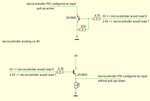gmorfeus
Junior Member level 1

Hi,
I am designing a circuit that has GPRS communication. The modem has an STATUS output but datasheet mentions only how to put a LED as in indicator (standard connection when LED is in collector side with an 300ohm resistor and emitter is connected to GND). I asked manufacturer if I can connect STATUS pin to the microcontroller PIN configured as input but they said better not to and that there is an AT command to figure out if modem is ON or OFF. Well, I would be happier to know it also "electrically" What I am not sure is if it is better to use NPN or PNP transistor for the task? As most of the time the modem will be ON, I would like to use as less current as possible to sense the modem ON/OFF state. By your opinion, what's better to use between designs attached in the post? Thanks!
What I am not sure is if it is better to use NPN or PNP transistor for the task? As most of the time the modem will be ON, I would like to use as less current as possible to sense the modem ON/OFF state. By your opinion, what's better to use between designs attached in the post? Thanks!

I am designing a circuit that has GPRS communication. The modem has an STATUS output but datasheet mentions only how to put a LED as in indicator (standard connection when LED is in collector side with an 300ohm resistor and emitter is connected to GND). I asked manufacturer if I can connect STATUS pin to the microcontroller PIN configured as input but they said better not to and that there is an AT command to figure out if modem is ON or OFF. Well, I would be happier to know it also "electrically"




